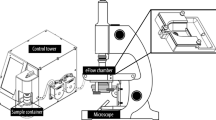Abstract
Purpose
To determine the precision and accuracy of Accu-Beads and their utility as a quality control product for manual and automated measurements of sperm concentration.
Methods
This observational study was performed at an Assisted Reproductive Technology laboratory in a tertiary-care, university hospital. To simulate sperm concentration, bead concentrations were measured with the use of a manual and an automated method.
Results
The manual counts did not vary significantly from the automated counts regardless of the concentration. However, the counts did vary between lots of low concentration of Accu-Beads and between the two different types of fixed counting chambers. The two bead concentrations used in this study were below the 95 % confidence interval for the values listed by the manufacturer.
Conclusion(s)
In our laboratory, Accu-Beads met enough of the requirements of a good control material to be acceptable for daily quality control use, especially if we set our own ranges of acceptability for each vial of Accu-Beads. It is necessary to evaluate each new lot of Accu-Beads when they are received and again if they are used with a different counting chamber.





Similar content being viewed by others
References
Johnson JE, Boone WR, Blackhurst DW. Manual versus computer-automated semen analyses. Part II. Determination of the working range of a computer-automated semen analyzer. Fertil Steril. 1996;65:156–9.
Johnson JE, Boone WR, Blackhurst DW. Manual versus computer-automated semen analyses. Part I. Comparison of counting chambers. Fertil Steril. 1996;65:150–5.
Álvarez C, Castilla JA, Ramírez JP, Vergara F, Yoldi A, Fernández A, et al. External quality control program for semen analysis: Spanish experience. J Assist Reprod Genet. 2005;22:379–87.
Mallidis C, Cooper TG, Hellenkemper B, Labians M, Uckert F, Nieschlag E. Ten years’ experience with an external quality control program for semen analysis. Fertil Steril. 2012;98:611.e4–6.e4.
WHO laboratory manual for the examination and processing of human semen. 5th ed. Switzerland: World Health Organization; 2010.
Westgard JO, Barry PL, Hunt MR. A multi-rule Shewhart chart for quality control in clinical chemistry. Clin Chem. 1981;27:493–501.
Johnson JE, Blackhurst DW, Boone WR. Can Westgard quality control rules determine the suitability of frozen sperm pellets as a control material for computer automated semen analyzers? J Assist Reprod Genet. 2003;20:38–44.
Baker HWG, Clarke GN. Sperm morphology: consistency of assessment of the same sperm by different observers. Clin Reprod Fertil. 1987;5:37–43.
Menkveld R, Stander FSH, Kotze TJVW, Kruger TF, van Zyl JA. The evaluation of morphological characteristics of human spermatozoa according to stricter criteria. Hum Reprod. 1990;5:586–92.
Ombelet W, Bosmans E, Janssen M, Cox A, Maes M, Punjabi U, et al. Multicenter study on reproducibility of sperm morphology assessments. Arch Androl. 1998;41:103–14.
Davis RO, Katz DF. Standardization and comparability of CASA instruments. J Androl. 1992;13:81–6.
Krause W, Viethen G. Quality assessment of computer- assisted semen analysis (CASA) in the andrology laboratory. Andrologia. 1999;31:125–9.
Cooper T, Hellenkemper B, Nieschlag E. External quality control for semen analysis in Germany- Qualitakontrolle der Deutschen Gesellchaft fur Andrologie (QuaDeGA) the first 5 years. J Reprod Med Endocr. 2007;4:331–5.
Keel BA, Quinn P, Schmidt Jr C, Serafy Jr N, Seafry Sr N, Schalue T. Results of the American Association of Bioanalysts national proficiency testing programme in andrology. Hum Reprod. 2000;15:680–6.
Mortimer S, Swan M. The development of smoothing-independent kinematic measures of capacitating human sperm movement. Hum Reprod. 1999;14:986–96.
Hu A, Lu JC, Shao Y, Huang YF, Lu NQ. Comparison of semen analysis results obtained from two branded computer-aided sperm analysis systems. Andrologia. 2012;1–4.
Mortimer D, Shu MA, Tan R. Standardization and quality control of sperm concentration and sperm motility counts in semen analysis. Hum Reprod. 1986;1:299–303.
Conflicts of interest
None of the authors has a conflict of interest.
Author information
Authors and Affiliations
Corresponding author
Additional information
Capsule
Accu-Beads can be used as a quality control material for manual and automated measurements of sperm concentration.
All funds for this research came from within the Medical Experience Academy and the Department of Obstetrics and Gynecology.
Rights and permissions
About this article
Cite this article
Vernon, D.D., Johnson, J.E., Houwing, A.M. et al. Accu-Beads as a quality control measure for manual and automated methods of measuring sperm concentration—an observational study. J Assist Reprod Genet 31, 25–33 (2014). https://doi.org/10.1007/s10815-013-0107-x
Received:
Accepted:
Published:
Issue Date:
DOI: https://doi.org/10.1007/s10815-013-0107-x




